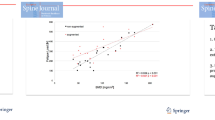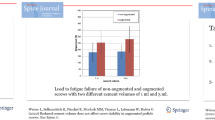Abstract
Purpose
Normal progression of osteoporosis or the rigid reinforcement of the fractured vertebral body with polymethyl methacrylate (PMMA) cement is being discussed as a cause for adjacent-level fractures after vertebroplasty. The purpose of this study was to investigate whether augmentation with low stiffness cement can decrease the risk of adjacent-level fractures in low-quality bone.
Methods
Eighteen female osteoporotic lumbar specimens (L1–L5) were harvested and divided into three groups according to bone mineral density: (I) native; (II) PMMA; (III) modified PMMA (lower stiffness). For the PMMA and modified PMMA groups, a compression fracture was first mechanically induced in L3, and then the fracture received vertebroplasty treatment. The cement stiffness reduction of the modified PMMA group was achieved via an addition of 8 mL of serum to the typical PMMA base. All specimens were exposed to cyclic loading (4 Hz) and a stepwise increasing applied peak force. Cement stiffness was tested according to ISO 5833.
Results
A 51 % decrease in cement stiffness was achieved in the modified PMMA group (954 ± 141 vs. 1,937 ± 478 MPa, p < 0.001). Fatigue fracture force (the force level during cyclic loading at which the deformation experienced a sudden increase; FFF) was significantly affected by bone quality (r 2 = 0.39, p = 0.006) and by the initial fracture force (the force necessary to create the initial fracture in L3 prior to augmentation; r 2 = 0.82, p < 0.001). Using initial fracture force as a covariate, the FFF of the modified PMMA group (1,764 ± 49 N) was significantly higher than in the PMMA group (1,544 ± 55 N; p = 0.03).
Conclusions
A possible method to reduce adjacent-level fractures after vertebroplasty in patients with reduced bone quality could be the use of a lower modulus cement. Therefore, mixing cement with biocompatible fluids could prove useful to tailor cement properties in the operating theater.





Similar content being viewed by others
Notes
FFF for the modified PMMA group was also significantly higher than the PMMA group when the FFF was normalized with the initial fracture force (FFF/IFF) rather than using the IFF as a covariate (p = 0.03). To account for differences of individual specimen geometry, an ANCOVA analysis comparing the change in apparent fatigue strength (FFF/endplate area) adjusted for apparent initial strength (IFF/endplate area) was performed. In accordance with the FFF analysis, the modified PMMA fatigue strength (1.30 ± 0.041 MPa, n = 6) was also significantly higher than in the PMMA group (1.07 ± 0.045 MPa, n = 5, F(1,8) = 11.99, η 2 = 0.60, p = 0.009, Fig. 5).
References
Riggs BL, Melton LJ (1995) The worldwide problem of osteoporosis: insights afforded by epidemiology. Bone 17(5):505–511
Burge R, Dawson-Hughes B, Solomon DH et al (2007) Incidence and economic burden of osteoporosis-related fractures in the United States. 2005–2025. J Bone Miner Res 22(3):465–475
Bartl R, Gradinger R (2009) Current diagnosis and therapy of osteoporosis on the basis of “European guidance 2008”. Orthopade 38(4):365–379
Arabmotlagh M, Rauschmann M (2010) Filler materials for augmentation of osteoporotic vertebral fractures. Orthopade 39(7):687–692
Cooper C, Atkinson EJ, Jacobsen SJ, O’Fallon WM, Melton LJ (1993) Population-based study of survival after osteoporotic fractures. Am J Epidemiol 137(9):1001–1005
Cotten A, Boutry N, Cortet B et al (1998) Percutaneous vertebroplasty: state of the art. Radiographics 18(2):311–320 discussion 320–323
Heini PF, Berlemann U, Kaufmann M et al (2001) Augmentation of mechanical properties in osteoporotic vertebral bones—a biomechanical investigation of vertebroplasty efficacy with different bone cements. Euro Spine J 10(2):164–171
Mathis JM, Barr JD, Belkoff SM et al (2001) Percutaneous vertebroplasty: a developing standard of care for vertebral compression fractures. AJNR Am J Neuroradiol 22(2):373–381
Hulme PA, Krebs J, Ferguson SJ, Berlemann U (2006) Vertebroplasty and kyphoplasty: a systematic review of 69 clinical studies. Spine 31(17):1983–2001
Klazen CAH, Venmans A, de Fies J (2010) Percutaneous vertebroplasty is not a risk factor for new osteoporotic compression fractures: results from Vertos II. AJNR Am J Neuroradiol 31:1447–1450
Trout AT, Kallmes DF, Kaufmann TJ (2006) New fractures after vertebroplasty: adjacent fractures occur significantly sooner. AJNR Am J Neuroradiol 27(1):217–223
Uppin AA, Hirsch JA, Centenera LV et al (2003) Occurrence of new vertebral body fracture after percutaneous vertebroplasty in patients with osteoporosis. Radiology 226(1):119–124
Boger A, Heini P, Windolf M, Schneider E (2007) Adjacent vertebral failure after vertebroplasty: a biomechanical study of low-modulus PMMA cement. Euro Spine J 16(12):2118–2125
Belkoff SM, Mathis JM, Erbe EM, Fenton DC (2000) Biomechanical evaluation of a new bone cement for use in vertebroplasty. Spine 25(9):1061–1064
Hadley C, Awan OA, Zoarski GH (2010) Biomechanics of vertebral bone augmentation. Neuroimaging Clin N Am 20(2):159–167
Ahn DK, Lee S, Choi DJ et al (2009) Mechanical properties of blood-mixed polymethyl metacrylate in percutaneous vertebroplasty. Asian Spine J 3(2):45–52
Banse X, Sims TJ, Bailey AJ (2002) Mechanical properties of adult vertebral cancellous bone: correlation with collagen intermolecular cross-links. J Bone Miner Res 17(9):1621–1628
Huber G, Müller-Bergen L, Sellenschloh K, et al. (2008) The influence of cement augmentation method on the fracture strength of augmented and adjacent vertebral bodies. In: 53rd Annual Meeting of the Orthopaedic Research Society, San Francisco
Broszyk (2010) Volume matters: a review of procedural details of two randomized controlled vertebroplasty trials in 2009. Eur Spine J 19:1837–1840
Locati L (1955) Le prove di fatica come ausilio alla progettazione ed alla produzione. Matallurgia It 47(9):301–308
Brinkmann P, Biggermann M, Hilweg D (1988) Fatigue fracture of human lumbar vertebrae. Clin Biomech 3:1–23
Huber G, Skrzypiec DM, Klein A, Püschel K, Morlock MM (2012) High cycle fatigue behaviour of functional spinal units. Ind Health 48(5):550–556
Luo J, Skrzypiec DM, Pollintine P et al (2006) Mechanical efficacy of vertebroplasty: influence of cement type, BMD, fracture severity, and disc degeneration. Bone 40(4):1110–1119
Kayanja MM, Togawa D, Lieberman IH (2005) Biomechanical changes after the augmentation of experimental osteoporotic vertebral compression fractures in the cadaveric thoracic spine. Spine J 5(1):55–63
Nouda S, Tomita S, Kin A et al (2009) Adjacent vertebral body fracture following vertebroplasty with polymethyl methacrylate or calcium phosphate cement. Spine 34(24):2613–2618
Ammann P, Rizzoli R (2003) Bone strength and its determinants. Osteoporos Int 14(3):13–18
Acknowledgments
Funding from the state of Hamburg and the Marie Curie ITN project SpineFX is kindly acknowledged. The authors would also like to thank Synthes GmbH for providing the cement.
Conflict of interest
Prof. Dr. Andreas Boger was formerly a Senior Project Scientist at Synthes GmbH until September 2011. No other authors have any declarations.
Author information
Authors and Affiliations
Corresponding author
Rights and permissions
About this article
Cite this article
Kolb, J.P., Kueny, R.A., Püschel, K. et al. Does the cement stiffness affect fatigue fracture strength of vertebrae after cement augmentation in osteoporotic patients?. Eur Spine J 22, 1650–1656 (2013). https://doi.org/10.1007/s00586-013-2809-2
Received:
Revised:
Accepted:
Published:
Issue Date:
DOI: https://doi.org/10.1007/s00586-013-2809-2




